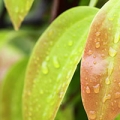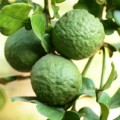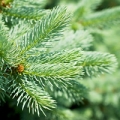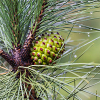Clove Bud Massage Essential Oil : Stimulating and Versatile Aromatic Oil
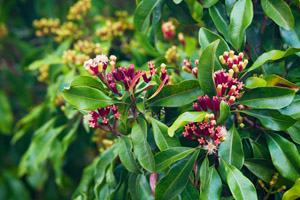 Clove bud essential oil is derived from the small reddish-brown, unripe flower buds of the tropical evergreen tree known botanically as Syzygium aromaticum, and in older texts Eugenia caryophyllata.
Clove bud essential oil is derived from the small reddish-brown, unripe flower buds of the tropical evergreen tree known botanically as Syzygium aromaticum, and in older texts Eugenia caryophyllata.
Like all spices, clove has a long and rich history of use in both culinary and medicinal applications, having been put to use first by the ancient Chinese and later imported into Alexandria for use throughout Egypt and Europe. Clove bud was also used in Indian Ayurvedic medicine over 2,000 years ago.
A necklace of cloves was discovered in a tomb alongside a mummy in Egypt, and during the Han-Dynasty (220-206 BC) in China, court officials were required to hold whole cloves in their mouths to sweeten their breath whilst addressing the Emperor. Later in Europe, doctors breathed through clove-filled leather beaks believing it would ward off the plague, and German herbalists also used clove in a treatment for gout.
Unknown origin
The precise origin of the clove tree has not been established but it seems most likely to have originated in the tropical climate of Asia, perhaps in the southern Philippines or Moluccas which are sometimes referred to as the Spice Islands. In 1524 the Portuguese took ownership of these islands to control the thriving clove market, since at that time clove production was limited to this group of islands.
However, karma will always have its way and in 1605 the Portuguese were driven out by the Dutch, who then began burning many of the clove trees to create scarcity and drive up prices for its precious buds which were by now literally worth their weight in gold. Soon the trees had been destroyed on all but two islands, Ambon and Ternate. The outraged natives began a bloody insurrection led by a man called Pattimura who is still remembered to this day as one of Indonesia’s heroes.
Despite the best efforts of the Dutch to dominate and monopolise the market, clove seeds were eventually smuggled by the French from these islands to others in the Indian Ocean and New World during the 1770’s. Today, clove trees are commercially grown in many countries including Brazil, Ceylon, Comores Islands, the Moluccas, Indonesia, Philippines, Madagascar, Mauritius, Sri Lanka, Sumatra, West Indies and Zanzibar.
Physical description
The clove tree belongs to the Myrtaceae family and is a handsome, pyramid-shaped evergreen tree which grows to a height of 6 to 12 metres (19ft to 39ft), depending upon the country it is grown in. The smooth grey branches spread out horizontally, with opposite ovate leaves which are a beautiful bright green. The entire plant is highly aromatic.
Clove trees are usually grown from seeds and do not flower until around the 6th year. The small green buds appear at the onset of the rainy season and develop in terminal clusters of 10 to 50 buds. These buds eventually reach a length of 18mm (3/4 inch) with a peach coloured corolla at the tip that fades as the calyx (outer case) develops, turning yellow and next to red.
Harvesting and extraction
When the bud heads have developed a pink caste they must be harvested quickly because if they begin to flower, the essential oil will be lost. After harvesting from the tree, the buds are spread out on mats and separated from the stems by hand which is a laborious process. They are then left to sun-dry for one or two days until the stems turn a dark brown and the heads a light tan colour.
Clove bud essential oil is distilled by water or sometimes steam, producing a fairly generous yield of approximately 15%. Essential oil of clove bud is a pale yellow to golden colour and has a rich fruity, almost floral note which is quite distinctive.
Benefits of clove bud essential oil
Surprisingly, clove bud essential oil is not commonly used in day-to-day aromatherapy, yet it excels when used in massage because its stimulating and analgesic action relieves muscular aches, stiff joints, sprains, arthritis and rheumatism, whilst its carminative and antispasmodic properties helps to relieve dyspepsia, colic and stomach cramps.
When blended with ginger, clove bud oil can also help settle an upset tummy and feelings of nausea, but always massage the abdomen in a clockwise direction when treating digestive conditions. It also has powerful antifungal and antibacterial properties that can be put to great use. To treat athletes foot put a few drops in a footbath, and then follow up with a lotion containing essential oils of clove bud, tagetes and lavender for the best results.
You can make a highly effective antibacterial mouthwash or gargle by simply adding just one or two drops of clove bud essential oil to a glass of water. One drop of clove bud oil on a cotton-bud applied to the gum can help to relieve toothache, but if it persists you must be brave and visit the dentist!
Clove bud essential oil has an uplifting, stimulating and strengthening effect on the mind which makes it helpful for lifting lethargic, melancholic and depressive states. Clove bud oil is a middle note that will add a spicy tang to almost any blend, and works particularly well when mixed with citrus and other spice oils such as orange sweet, cinnamon, black pepper, ginger and nutmeg. The classic blend of sweet orange and clove bud in your vaporiser creates an instant enlivening effect. It also blends well with bay, bergamot, chamomile roman, clary sage, geranium, jasmine, lavender, lemon, mandarin, palmarosa, rose, sandalwood, vanilla and ylang ylang.
Mistaken identity
Clove bud essential oil is often stated to be a skin irritant, although when tested on humans (Opdyke 1975 p.761), undiluted clove bud oil produced no irritation or sensitisation at a concentration of 5%. Better to err on the side of caution though and therefore always use this oil at a concentration of 1% maximum. Additionally, do not use clove bud essential oil on hypersensitive, damaged or diseased skin, or on children under the age of 2 years.
I believe the bad reputation of clove bud oil is due to the two other types of essential oil that are derived from the clove tree; clove leaf and clove stem. These culprits are known to cause skin irritation, and unfortunately they are often passed-off as clove bud oil by unscrupulous suppliers since they cost considerably less than true clove bud oil.
Therefore, when buying this useful oil, make certain it is labelled as ‘Clove Bud’ and not just ‘Clove’ or you can be sure it will be either oil from the leaf or stem, or perhaps even a blend of both. Remember, you get what you pay for with essential oils.
Browse Quinessence Clove Bud Essential Oil
Copyright © Quinessence Aromatherapy Ltd 2022.

